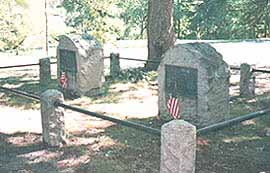The Battle of Chantilly (Ox Hill)
was fought on September 1, 1862, following the Battle of Second Manassas (Second Bull Run).
General Thomas "Stonewall" Jackson encountered
the Union troops of General Isaac Stevens as they were
retreating from Manassas, and a battle ensued late that
afternoon amidst a torrential downpour. I was Aide de Camp to General Kearny, and accompanied him during the Battle of Chantilly, when he rode on in advance of his Division to see the position occupied by the troops of General Stevens whom we were to relieve or reenforce. We rode along the line, and General Kearny sent off one staff officer after another with orders, until I was the only one left with him. We finally arrived at the right of Stevens' line, where a battery was shelling the opposite woods. The General ordered me to ride at a gallop, back to General Pope, commanding one of our Brigades, and order him to "double-quick" his brigade to that point and go into line. I did so, and returned as quickly as possible to the Battery. The rain was falling fast and darkness was coming on. I inquired of the Battery men which way General Kearny went, and they replied, pointing down to the right and front, "that way." "My God," was my exclamation, "we have no troops there, he has ridden right into the enemy lines." And so it proved. Wishing to know the nature of the ground and whether the woods were occupied or not, he rode with his usual bravery, to his death, as we learned from the Confederates, who next day brought in his body under a flag of truce. The General rode up to a whole company of the enemy, paid no attention to their demand that he surrender, wheeled his horse and started back. The whole company fired a volley, but only one bullet struck him; that entered his hip as he lay low along the horse, and came out at the shoulder. And so fell the most picturesque and gallant soldier that it was my fortune to meet during the war.* Philip Kearny's body and personal effects were passed over the lines under a flag of truce. He was buried at Trinity Churchyard in New York City, then moved to his final burial spot at Arlington National Cemetery in Virginia in 1912. Two years later, Kearny's former soldier Charles Hopkins erected an equestrian monument bearing the general's likeness in bronze upon his gravesite. The following year, 1915, Hopkins had monuments to Stevens and Kearny placed on the battlefield. These stone markers were spared destruction in recent years due to the caring work of local historians. (See images of these monuments and read their inscriptions in the section "Ox Hill Battlefield Park" below.)
* William B. Styple, Letters from the Peninsula: The Civil War Letters of General Philip Kearny (New Jersey: Belle Grove Publishing Company, 1988), p. 173. Special thanks to Bill Styple and to Brian Pohanka for their contributions to the body of this article. Established
in the late 1980s, Ox Hill Battlefield Park sits amidst
housing units and a shopping center: an island of a plot
representing all that remains of the Battle of Chantilly.
Thanks to the work done by Chantilly Battlefield
Association—co-founded by Ed Wenzel and Brian
Pohanka—and the trustees of the monument plot at Ox
Hill Battlefield Park, these monuments and what little
there is left of the battlefield still exist.
Index to Kearny's Pages
Copyright © 2001 - 2009 1st Dragoon's Civil War Site. All rights reserved. |
|||||||||||||


